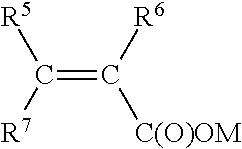Low-to-Mid Range Water-Reducing Polymer With Mixed Polyoxyalkylene Side Chains
- Summary
- Abstract
- Description
- Claims
- Application Information
AI Technical Summary
Benefits of technology
Problems solved by technology
Method used
Image
Examples
example 1
[0062]This section describes an exemplary process for making a comb-type carboxylate copolymer for low-to-mid-range water reduction use in accordance with the present invention. A three-neck round bottom flask was fitted with a mantle heater, a thermocouple connected to temperature controller and a mechanical stirrer. The reactor was charged with a prescribed amount of de-ionized water, purged with argon gas and then heated to 65° C. A solution containing prescribed amounts of two poly(ethylene glycol)methyl ether methacrylate (MPEGMA) having different molecular weights, acrylic acid (AA), 3-mercaptopropionic acid and de-ionized water was prepared in advance. Separately, a solution of ammonium persulfate in de-ionized water was prepared. Once the temperature of the reactor reached 65° C., both solutions were added drop-wise over a period of 5.0 hours while stirring. After the addition was completed, the reaction was continued for another 1.0 hour at 68-70° C. and then stopped by coo...
example 2
[0066]This example illustrates the water-reducing effect of the comb-type carboxylic copolymers of the present invention by measuring the slump of concrete. Concrete mixes were fabricated using three different mix proportions as shown in Table 2. The amount of water varied depending on the type and amount of cement and depending on the weight ratios of water to cement (w / c). The results shown in Table 3 below are based on cement sourced from Holcim Theodore plant (Alabama, US), slump was measured as a function of percentage of active polymer dosage to cement [% s / c].
TABLE 2Cement (lb / yd3)650564517Sand (lb / yd3)144114391384Stone ⅜″ (lb / yd3)425425438Stone ¾″ (lb / yd3)127512751313
TABLE 3650 lbs of650 lbs of564 lbs of564 lbs of517 lbs ofcementcementcementcementcementw / c = 0.38w / c = 0.38w / c = 0.53w / c = 0.53w / c = 0.60DosageSlumpDosageSlumpDosageSlumpDosageSlumpDosageSlumpSample ID[% s / c][mm][% s / c][mm][% s / c][mm][% s / c][mm][% s / c][mm]Sample 10.106.630.093.130.076.880.055.250.056.50Sample 20...
example 3
[0067]In this example, the performance of the comb-type copolymers of the invention was evaluated in a different cement, sourced from Holcim's Ste. Genevieve plant (Missouri, US). The test protocol described in Example 2 was employed and the results are summarized in Table 4.
TABLE 4650 lbs of650 lbs of564 lbs of517 lbs ofcementcementcementcementw / c = 0.42w / c = 0.42w / c = 0.53w / c = 0.60DosageSlumpDosageSlumpDosageSlumpDosageSlumpSample ID[% s / c][mm][% s / c][mm][% s / c][mm][% s / c][mm]Sample 10.097.130.074.880.0670.056.13Sample 20.097.000.074.630.067.380.056.00Reference 10.097.630.075.630.066.130.055.00Reference 20.098.000.076.25——0.055.63
[0068]The results in Table 4 indicate that the comb-type copolymers have two different polyoxyalkylene side chains outperformed the Reference polymers when the water to cement ratio is increased.
PUM
| Property | Measurement | Unit |
|---|---|---|
| Temperature | aaaaa | aaaaa |
| Percent by mass | aaaaa | aaaaa |
| Percent by mass | aaaaa | aaaaa |
Abstract
Description
Claims
Application Information
 Login to View More
Login to View More - R&D
- Intellectual Property
- Life Sciences
- Materials
- Tech Scout
- Unparalleled Data Quality
- Higher Quality Content
- 60% Fewer Hallucinations
Browse by: Latest US Patents, China's latest patents, Technical Efficacy Thesaurus, Application Domain, Technology Topic, Popular Technical Reports.
© 2025 PatSnap. All rights reserved.Legal|Privacy policy|Modern Slavery Act Transparency Statement|Sitemap|About US| Contact US: help@patsnap.com



